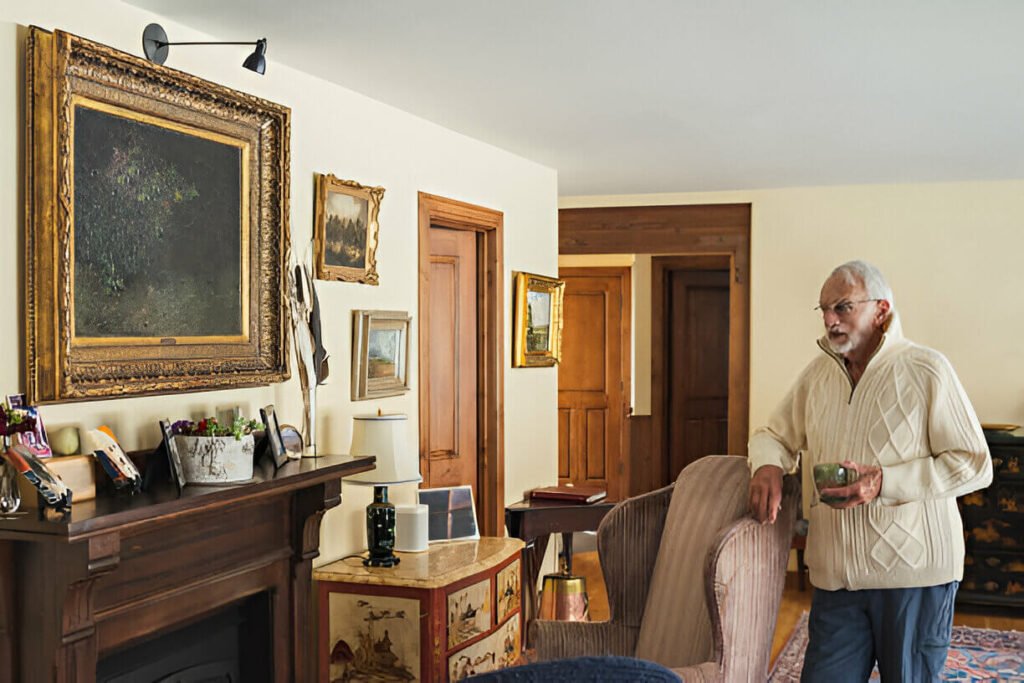As artists, we pour our hearts into each canvas, but over time, our styles and interests evolve. Inevitably, we’re left with a stockpile of old paintings that no longer resonate with us or align with our current artistic vision. These forgotten artworks gather dust in the corners of our studios, taking up precious space and leaving us with a nagging sense of waste.
For those committed to sustainable practices, the idea of simply discarding these once-cherished pieces feels deeply unsettling. We’ve invested time, energy, and materials into their creation, and the thought of contributing to the ever-growing mounds of waste is profoundly unsettling. Yet, the dilemma persists: what can we do with these outdated artworks that no longer serve their original purpose?
Potential of Repurpose Old Paintings
Breathing new life into old, unwanted paintings is an exciting creative opportunity for artists. Repurposing not only gives forgotten artworks a second chance but also aligns with sustainable practices and cost-effective approaches. By reimagining and transforming existing pieces, you can explore innovative techniques while reducing material waste.
The act of repurposing sparks inventiveness, challenging you to see beauty and potential in the discarded or overlooked. Rather than starting from a blank canvas, you have a unique foundation to build upon, allowing your creativity to take an unexpected path. This creative reuse is also an eco-friendly choice, as you’re preventing perfectly good materials from ending up in landfills.
For artists on a budget, repurposing old paintings can be a cost-effective solution. Instead of purchasing new canvases or materials, you can work with what you already have or can easily source secondhand. This approach not only saves money but also encourages resourcefulness and a mindset of making the most of what’s available.
Overall, repurposing old paintings offers a chance to merge artistic expression with sustainability and affordability. By embracing this practice, you can give new life to forgotten pieces while exploring your creativity in fresh, eco-friendly ways.
Painting Over the Existing Artwork
One of the most straightforward ways to breathe new life into an old painting is to simply paint over it. This allows you to start fresh on a pre-stretched canvas while reducing waste. However, there are a few important considerations when painting over oils.
First, it’s crucial to properly prepare the surface by applying an acrylic gesso or primer. These will create a sealed, absorbent layer over the old oils, allowing new acrylic or oil paints to adhere properly. When applying gesso or primer, use a stiff brush to work the product into the canvas weave for optimal coverage and adhesion.
For oil paintings, it’s best to use an oil-based primer or gesso to avoid incompatibility issues between the layers. An acrylic primer can be used, but may risk delamination over time as the oil painting continues curing underneath. No matter which primer you choose, allow it to fully dry per the manufacturer’s instructions before beginning your new painting.
If painting over oils with acrylics, you’ll want to fully prime and seal the surface first. The oils may leach through thin acrylic layers over time. For oils over oils, a thinner primer coat may suffice, though a more substantial layer will help mask any underlying brushwork or texture from the original artwork.
With a properly primed, sealed surface, you can then tap into your creativity. Consider the history and energy of the underlying artwork as you apply new brushstrokes. The original painting adds an invisible layer of texture and artistic legacy for you to build upon.
Collage and Mixed Media Techniques
One of the most versatile ways to breathe new life into an old painting is through collage and mixed media techniques. By layering new materials onto the existing surface, you can create a dynamic, textured piece that combines the history of the original artwork with fresh, contemporary elements.
Start by considering the composition and color palette of the existing painting. Look for areas where you can add contrasting textures or shapes to create visual interest. Cut out shapes or images from magazines, maps, or other paper ephemera and adhere them directly onto the canvas using a matte medium or gel medium. You can also incorporate found objects, such as buttons, fabric scraps, or small trinkets, by attaching them with a strong adhesive or embedding them into layers of gel medium.
For a more abstract approach, try tearing or cutting the original painting into smaller pieces and rearranging them into a new composition. You can leave gaps between the pieces, allowing the underlying canvas or a new background color to show through, or overlap the fragments for a more layered effect. Experiment with different orientations and arrangements until you find a composition that resonates with you.
Remember, mixed media art is all about experimentation and embracing unexpected combinations of materials. Don’t be afraid to try unconventional techniques, such as sanding down areas of the original painting to create a distressed texture or using a heat tool to manipulate and distort certain elements. The key is to let your creativity flow and embrace the unique character that emerges from repurposing an old work of art.
Salvaging Parts of the Original
One creative approach is to carefully disassemble or deconstruct parts of the original painting to repurpose them into new works of art. With some paintings, you may find sections or elements that are particularly appealing – whether it’s an intriguing texture, color palette, or compositional element. By carefully cutting these out, you can incorporate them into mixed media collages or assemblages.
The wooden frame itself can also be reused and given new life. Frames can be sanded, repainted, or embellished to serve as the basis for a new artwork. Or the wood can be cut into shapes or pieces for collaging. Similarly, the stretcher bars that originally held the canvas can be reused for assemblages or even woven together into sculptural forms.
If the goal is to fully reuse the original canvas surface, it’s possible to carefully remove the canvas from its stretcher bars. This allows you to preserve the canvas surface for transferring images, collaging onto, or even repainting completely. Just be cautious when attempting this, as canvases can be fragile, especially with age. Going slowly and using the right tools is essential to avoid damaging the canvas surface.
Creative Reuse in New Artworks
Giving new life to an old painting doesn’t have to mean completely obscuring the original artwork. With a bit of creativity, you can integrate elements of the existing piece into fresh, contemporary creations. One approach is to cut or tear sections from the canvas and incorporate them into mixed media collages. The textured paint layers can provide beautiful depth and visual interest when combined with other materials like papers, fabrics, and found objects.
For assemblage artists, old canvas remnants can be the perfect lightweight, moldable components. Try wrapping them around sculptural forms, allowing the painted surfaces to bring color and movement to your 3D pieces. Stretched over wire armatures, they can become the “skin” of whimsical creatures or abstract shapes.
Another option is to transfer images from the original painting onto new surfaces like wood, metal, or clay. There are various transfer techniques involving solvents or gel mediums that can help you capture and adhere the image in a new context. This allows you to repurpose the most compelling elements while exploring different textures and displaying the artwork in an unconventional way.
No matter which method you choose, don’t be afraid to experiment. The goal is to breathe new energy into those forgotten artworks while reducing waste and celebrating the history contained within each layer of paint. Your unique perspective will transform the old into something innovatively beautiful.
Taking Safety Precautions
When working with old oil paintings, it’s crucial to take the necessary safety precautions to protect yourself and your workspace. Oil paints contain solvents and pigments that can be toxic if inhaled or absorbed through the skin. Proper ventilation and protective gear are essential.
Ensure your workspace has adequate ventilation by opening windows and doors, using fans, or setting up an exhaust system. If possible, work outdoors or in a well-ventilated area. Avoid breathing in fumes or dust from sanding or scraping old paint layers.
Wear protective gear, such as a respirator mask designed for solvent vapors, goggles, and nitrile gloves. These precautions will prevent you from inhaling harmful particles or getting paint residue on your skin.
Before repainting over an old oil painting, it’s crucial to prepare the surface properly. Lightly sand the existing paint layers to create a rough surface for better adhesion. Then, apply an oil-based primer or gesso to seal the old paint and provide a fresh surface for your new artwork.
Remember, safety should always be a top priority when working with art materials, especially those containing solvents or toxic substances. By taking the necessary precautions, you can enjoy the creative process of repurposing old paintings while protecting your health and the environment.
Tips for Sourcing Materials
One of the joys of repurposing old paintings is the thrill of the hunt in sourcing affordable materials. Thrift stores and garage sales are treasure troves for finding unwanted artworks ripe for reinvention. Scan the shelves for interesting frames, canvases peeking out from behind other items, or even paintings you can remake entirely.
Online listings on sites like Craigslist, Facebook Marketplace, or specialty art groups are another fruitful avenue. Often people are just looking to clear out old art supplies and canvases from their homes. You may even know friends or family members decluttering who would be happy to pass along their unused paintings.
The beauty is in the story behind each piece you can reimagine. An outdated landscape could become the layers for an abstract collage. A drab still life offers a fresh start to unleash your creativity. With a keen eye and open mind, you can breathe new life into forgotten artwork in unexpected ways.
Examples from Eco-Artists
Sustainable artists around the world are embracing creative reuse as both an environmental stance and an artistic technique. By repurposing discarded materials and breathing new life into forgotten objects, these eco-artists transform the ordinary into the extraordinary.
Noah Deledda is an Italian artist who scours city streets for abandoned canvases, frames, and art supplies. His mixed media collages layer found papers, acrylics, and salvaged canvas pieces into abstract compositions. Deledda views his process as a collaboration with the previous artists, stating “I’m giving these materials a second chance to be seen and appreciated.”
In Australia, Delya Blacklock specializes in encaustic paintings made from repurposed beeswax and resin. Her vibrant abstracts often incorporate recycled papers, textiles, and wood scraps. Blacklock aims to minimize waste while creating depth and texture. “Every layer holds a story,” she explains. “My art preserves little pieces of the past.”
Fernando Llort, a Spanish multimedia artist, elevates trash into thought-provoking installations. His massive sculptures are constructed from discarded plastics, broken furniture, and salvaged housewares. Llort’s work critiques our throwaway culture while demonstrating how creatively reused objects can spark conversations about sustainability.
These visionary artists are part of a growing eco-art movement that champions upcycling, recycling, and sustainable practices. By giving new purpose to society’s castaways, their artwork inspires us to see beauty in the discarded and possibility in the forgotten.
Sparking New Creative Energy
Repurposing old paintings isn’t just a sustainable way to reduce waste and cut costs on art supplies. It’s also an incredibly inspiring creative exercise that can spark new energy and ideas in your artistic practice.
By taking an existing artwork and transforming it into something new, you’re engaging in a form of creative problem-solving. You’re challenged to look at the original piece through a new lens and envision its untapped potential. This forces you to think outside the box and stretch your artistic muscles in unexpected ways.
Working with found materials and pre-existing compositions adds an exciting element of spontaneity. The original painting provides a launching point, but where you take it from there is up to your imagination and personal style. Embrace the journey of exploration and don’t be afraid to experiment boldly.
So go ahead, gather those old canvases collecting dust and dive into the world of repurposing. You may be surprised by the innovative mixed media pieces, collages, and assemblages that emerge. And who knows? The creative energy sparked by breathing new life into old art could lead you down an entirely new artistic path. The possibilities are limitless when you open your mind to sustainable reinvention.

Tonja Nichols Ray is a creative author and DIY enthusiast who shares her passion for repurposing old items on social media. On her Instagram account @tonja.nichols, she showcases beautiful transformations of everyday objects into unique and functional pieces.
As a contributor to the website scrapsafari.com, Tonja writes detailed guides and tutorials, helping her readers discover the joys of breathing new life into vintage and discarded materials. With an eye for design and a knack for crafting, she inspires her followers to approach home decor and personal projects from a sustainable, eco-friendly perspective.


